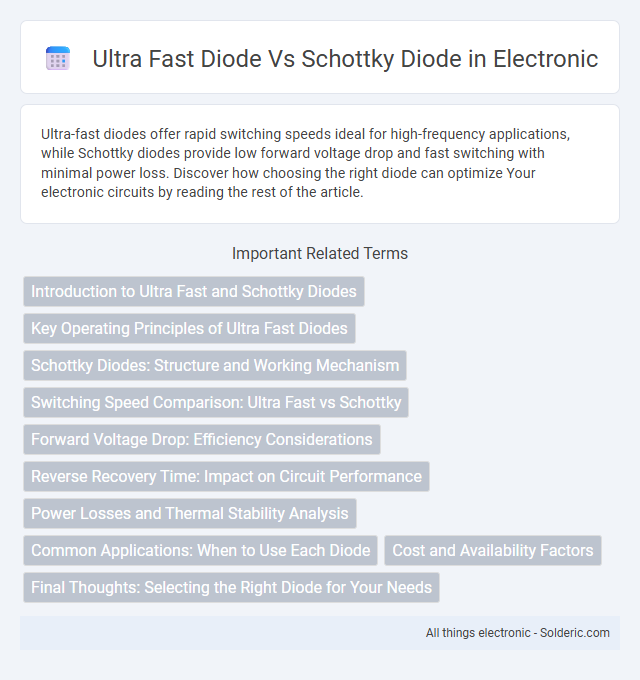Ultra-fast diodes offer rapid switching speeds ideal for high-frequency applications, while Schottky diodes provide low forward voltage drop and fast switching with minimal power loss. Discover how choosing the right diode can optimize Your electronic circuits by reading the rest of the article.
Comparison Table
| Feature | Ultra Fast Diode | Schottky Diode |
|---|---|---|
| Recovery Time | Few nanoseconds (fast switching) | Very fast, typically <10ns (near-instantaneous) |
| Forward Voltage Drop | Typically 0.7V | Lower, around 0.2V - 0.3V |
| Reverse Leakage Current | Low, typically in microamps | Higher, due to metal-semiconductor junction |
| Junction Type | PN junction | Metal-semiconductor junction |
| Applications | High-speed switching, rectifiers in switching power supplies | Low voltage rectification, RF circuits, power supplies |
| Temperature Range | Typically -65degC to 150degC | Typically -55degC to 125degC |
Introduction to Ultra Fast and Schottky Diodes
Ultra fast diodes feature rapid reverse recovery times, typically in the nanosecond range, making them ideal for high-frequency switching applications such as in power converters and RF circuits. Schottky diodes utilize a metal-semiconductor junction, resulting in a low forward voltage drop (typically 0.2 to 0.3 volts) and extremely fast switching speeds with minimal charge storage. Both diode types optimize efficiency and thermal performance but are chosen based on specific circuit requirements involving speed, voltage, and current characteristics.
Key Operating Principles of Ultra Fast Diodes
Ultra fast diodes operate based on a rapid recovery time that minimizes charge carrier storage during switching, enabling high-speed rectification in power electronics. Their key operating principle involves a thin diffusion layer that allows quick removal of stored charge, reducing reverse recovery time compared to standard diodes. This fast switching characteristic makes ultra fast diodes ideal for applications requiring efficient high-frequency operation, such as switch-mode power supplies and inverters.
Schottky Diodes: Structure and Working Mechanism
Schottky diodes feature a metal-semiconductor junction, which differs from the p-n junction in ultra fast diodes, enabling lower forward voltage drop and faster switching speeds. Their operation relies on majority carriers, minimizing charge storage and resulting in negligible reverse recovery time. Your circuit benefits from Schottky diodes when high efficiency and rapid switching are crucial due to their unique structure and working mechanism.
Switching Speed Comparison: Ultra Fast vs Schottky
Ultra fast diodes typically offer switching speeds in the range of nanoseconds, making them ideal for high-frequency applications where rapid recovery time is essential. Schottky diodes, while faster than standard diodes with switching times measured in picoseconds to nanoseconds due to their majority carrier conduction, also exhibit lower forward voltage drops that enhance efficiency. The choice between ultra fast and Schottky diodes depends on the specific switching speed requirements, reverse voltage ratings, and conduction losses in power electronic circuits.
Forward Voltage Drop: Efficiency Considerations
Ultra fast diodes typically have a higher forward voltage drop (around 0.7V to 1.0V) compared to Schottky diodes, which usually feature a lower forward voltage drop of approximately 0.2V to 0.4V. The lower forward voltage drop in Schottky diodes results in reduced power loss and improved efficiency, especially in low-voltage, high-frequency applications. This efficiency advantage makes Schottky diodes preferable in power supply circuits and switching regulators where minimizing energy dissipation is critical.
Reverse Recovery Time: Impact on Circuit Performance
Ultra fast diodes exhibit significantly shorter reverse recovery times compared to standard Schottky diodes, which enhances their performance in high-speed switching applications by reducing switching losses and electromagnetic interference (EMI). Schottky diodes, while known for low forward voltage drop and fast switching, generally have longer reverse recovery times, affecting circuit efficiency in high-frequency environments. Selecting ultra fast diodes improves overall circuit responsiveness and thermal management in power electronics by minimizing energy dissipation during diode turn-off.
Power Losses and Thermal Stability Analysis
Ultra fast diodes exhibit lower reverse recovery time compared to standard diodes, reducing switching losses and improving efficiency in high-frequency applications, but they generally have higher forward voltage drop than Schottky diodes, which can increase conduction power losses. Schottky diodes feature lower forward voltage drop and minimal reverse recovery current, resulting in reduced power losses and better thermal efficiency under moderate current loads, but their lower thermal stability and maximum junction temperature limit their use in high-temperature environments. Thermal analysis shows ultra fast diodes tolerate higher junction temperatures, offering improved reliability in harsh thermal conditions, while Schottky diodes require careful heat dissipation design to avoid thermal runaway.
Common Applications: When to Use Each Diode
Ultra fast diodes are commonly used in high-frequency switching power supplies, inverters, and high-speed rectification circuits due to their rapid recovery time and low reverse recovery charge. Schottky diodes excel in low-voltage, high-efficiency applications like power rectifiers and RF circuits because of their low forward voltage drop and fast switching capabilities. Choose ultra fast diodes for circuits requiring minimal switching losses at high frequencies, while Schottky diodes are ideal for reducing power dissipation in low-voltage, high-current scenarios.
Cost and Availability Factors
Ultra fast diodes typically offer lower cost and wider availability than Schottky diodes due to simpler manufacturing processes and more established supply chains. Schottky diodes, while providing superior switching speed and lower forward voltage drop, often come at higher prices and limited stock depending on specific voltage and current ratings. Considering your budget and component scarcity, ultra fast diodes can be a more economical choice for mass production or general-purpose applications.
Final Thoughts: Selecting the Right Diode for Your Needs
Ultra fast diodes offer higher reverse recovery speed and lower switching losses, making them ideal for high-frequency applications requiring efficiency. Schottky diodes provide lower forward voltage drop and minimal noise, optimizing performance in low voltage and high-speed switching circuits. Assess Your specific voltage, current, and switching speed requirements to select the diode that best enhances your system's performance.
Ultra fast diode vs Schottky diode Infographic

 solderic.com
solderic.com